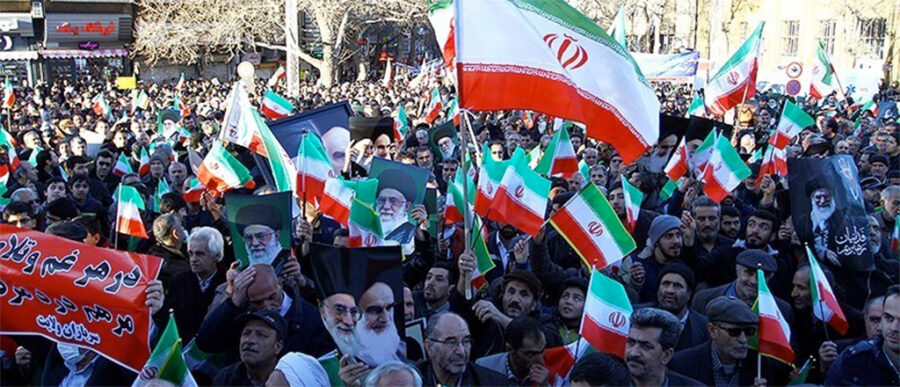The widespread unrest in Iran over the past week that saw thousands protest over the economy, inflation, corruption and unemployment may not bring much-needed political reforms and economy boosters. Instead, the government could try and placate protesters, especially those from smaller towns, with populist measures such as cash transfers and energy subsidies, according to experts at Wharton and elsewhere.
Iran’s Revolutionary Guards said over the weekend that the unrest had ended, but it has left 22 dead, and more than 1,000 people were arrested. The country’s government blamed the U.S., the U.K., Israel and Saudi Arabia among others for fomenting the unrest. The U.S. has said it supports the protesting Iranians and called upon the international community “to stand with their cause.” Iran’s government, in its attempt to prevent what it called “cultural invasion,” last week also banned the teaching of English in primary schools.
The unrest began on December 28 in Mashhad, Iran’s second-largest city, with working-class people protesting against rising prices. Not all Iranians had benefitted from the lifting of nuclear sanctions against the country in 2015, which allowed Iran to reclaim frozen oil assets and revenues. The sanctions were lifted after Iran struck an agreement with Western powers to scale back its nuclear ambitions. Meanwhile, a shaky banking sector, depleted government funds and a severe drought have worsened the country’s economic situation.
The protests caught everyone by surprise, especially both factions within the ruling elite, said Nader Habibi, an economics professor at Brandeis University’s Crown Center for Middle East Studies. “Over time, the protests have evolved from grievances about economic conditions to broader demands for political freedom and political change,” he added. Many protesters have called for the ouster of both Iran’s president Hassan Rouhani and the country’s Supreme Leader Ayatollah Ali Khamenei.
“Over time, the protests have evolved from grievances about economic conditions to broader demands for political freedom and political change.” –Nader Habibi
Widespread Outrage
Djavad Salehi-Isfahani, an economics professor at Virginia Tech, noted that while demonstrations are common in Iran, what was new about the latest unrest is that “the rage spread to smaller cities.” Yet, he said that in some senses it was not surprising, given that Iranians have been under sanctions and bad economic management for several years. “The standard of living has been declining and unemployment is very high,” he said. “It’s very inviting for this kind of unrest. Once you get a little spark, it spreads fast and wide.”
Wharton legal studies and business ethics professor Philip Nichols said the unrest “could be viewed as part of a global outrage by the people who have been disaffected by the economic downturn since 2007-2008.”
Habibi, Salehi-Isfahani and Nichols discussed the likely outcomes of Iran’s unrest on the Knowledge at Wharton show on Wharton Business Radio on SiriusXM channel 111. (Listen to the podcast at the top of this page.)
Salehi-Isfahani said the Iranian government had reason to believe that the U.S. and others were inflaming the protests. “There have been so many threats against the Islamic Republic [of Iran] for many years from the U.S., Israel and Saudi Arabia.” However, he said that given the volume of economic grievances, “it would be foolish to attribute this entire thing to foreign meddling.”
Impact of Sanctions
Habibi said there is some acknowledgment within the government that the grievances over economic conditions are legitimate. “For example, the sanctions have been over for two years, but that has not led to significant material improvement for large factions in the society.”
According to Habibi, the lifting of the nuclear sanctions in 2015 did allow Iran to increase trade with Europe and Asia. However, attempts to bring sustainable economic growth are thwarted by an inherent weakness in Iran’s governance, he said. “There are two factions. Whenever one faction is ruling, the other faction tries to undermine it.”
Nichols pointed out that some crippling sanctions continue, such as those by the U.S. on banking, “which extraordinarily complicates any foreign investment into Iran.” The French oil and gas company Total has sought to overcome that by routing payments through Chinese banks, he noted, but described that as “an extraordinarily complicated way to try to do foreign investment.”
In the two years following the lifting of the nuclear sanctions, Iran has attracted just short of $25 billion in foreign investment, “which is substantially below where Iran should be given the size of its economy,” said Nichols. “Most foreign investors who look at Iran have come back saying that the environment is just too unpredictable, partially because of the difficulty in using dollar-based banking in Iran, but also because of the inept local governments and the severe amounts of corruption.”
Salehi-Isfahani said that while large companies like Total may find ways to continue to invest in Iran’s economy, more effort is required to attract smaller investors. “Remember that the energy sector is very capital-intensive, and it does not create the kind of jobs that people in small cities who are now protesting are likely to get,” he added.
Need for an Internal Strategy
According to Salehi-Isfahani, what Iran really needs is an internal strategy. For starters, the country has sufficient domestic resources to create more jobs, he said. But it has several obstacles on that path. It has a severe banking crisis, and its interest rates are among the highest in the world. “Some of the money that’s coming in is really coming to take advantage of that, because the exchange rate has been fairly stable, interest rates exceed the rate of inflation by 5% to 10%, and the banks are not lending money to the private sector.” Also, Iran’s banking sector is not equipped to meet global regulations against money laundering, he added.
“The Islamic Republic has been a very successful poverty-reduction enterprise, but not good at producing jobs.” –Djavad Salehi-Isfahani
Unemployment in Iran is particularly pronounced among millennials and women, Salehi-Isfahani said. “Most people over [the age of] 30 have jobs in Iran – the unemployment rate for them is about 5%,” he said. “But when you look at young people, especially young women, unemployment rates are very high – for women it’s over 40%, and for young men it’s over 20%. This has been going on for a decade.”
Salehi-Isfahani said people placed their hopes on Rouhani when they re-elected him in 2017. But Rouhani has blamed the banking crisis, the remaining sanctions, and problems in dealing with the opposition parties, he noted. The upshot of all that for ordinary Iranians is uncertainty. “What are they supposed to think? How are they going to plan their lives? For young people this is a very difficult situation.”
Nichols noted that the Iranian youth seem to be “very disorganized” and have no charismatic or intellectual leader. “Right now the best organized groups in Iran are the clerics, the Conservative Party and particularly the Iranian Revolutionary Guard – will they perpetuate themselves as the best organized group, or will something emerge from this huge disaffected body? And if so, what’s going to evolve from that?”
Social media has played “a big role” in triggering the unrest in Iran, especially Telegram, the dominant platform in the country, said Salehi-Isfahani. The government has lifted curbs on most social media after the protests grew weaker, but those on Telegram continue.
Iran is also facing a severe drought which dragged growth in agricultural output to 0.2% last year, down from levels of 5%-6% in earlier years, said Salehi-Isfahani. “Villagers are not expecting any improvement in the weather conditions because Iran is now in that area where drought will become much more severe with global warming,” he said. “They are probably starting to move to cities, but then in the cities the conditions aren’t all that much better.”
Respite Ahead?
In weeks before the latest crisis erupted, Rouhani had presented budget proposals that allocated $100 billion for public service programs to create jobs, address a banking crisis and introduce a new social security program, according to Bloomberg. However, the new realities after last week’s protests may call for a fresh approach.
“How those protests will translate into changing public policy is not clear because the political system in Iran is closed,” Habibi said. “Key demands for a substantial political or cultural change have been blocked repeatedly for the past 40 years.” On the economic front, too, problems loom. In addition to a banking crisis, Iran’s retirement fund has been depleted by government withdrawals. He warned of “a crisis in the coming months because of the shortage of funds to pay the retirement salaries.”
“A very common misunderstanding is that Iranian youth want to be just like us. They don’t. They want to be freer to be what they want to be.” –Philip Nichols
Habibi expected the government to redirect some resources to poor and marginalized small towns. “What we observed in the past seven days is that the protests were more visible in small towns where unemployment and poverty are much more [prevalent] than Tehran and large cities,” he said. “This might make the politicians aware of the neglect of the smaller towns and low-income marginalized areas, and perhaps distant provinces from Tehran.”
Salehi-Isfahani agreed with Nader that the government might tailor programs to small cities. He noted that Iran is highly globalized with its oil exports and imports. “Remember that the Islamic Republic has been a very successful poverty-reduction enterprise, but not good at producing jobs,” he said. “I think they’re going to fall back on populism.” He expected more cash-transfer programs, energy subsidies and the like.
One big factor driving that populism could be the fact that the gains of globalization have eluded many Iranians. “What is clear is that this kind of globalization doesn’t really have an egalitarian distribution of benefits across the regions and across social classes,” Salehi-Isfahani noted.
In the coming year, Habibi said he expected more pressure within Iran to change its foreign policy. “[People] don’t want to make so much sacrifice for the government’s desire to confront the United States and Israel,” he added. On the other hand, Iran might continue with its hardline foreign policy, “which is going to cause a military risk, an economic risk and a sanctions risk on the domestic economy.”
Nichols felt the statements supporting the Iranian people from Nikki Haley, the U.S. ambassador to the United Nations, have not helped. “A very common misunderstanding is that Iranian youth want to be just like us,” he said. “They don’t. They want to be freer to be what they want to be. The statements from the U.S. administration that we support them 100% can be used as fuel for the Iranian administration saying this is foreign intervention. Those statements are inconsequential or deleterious.”
Image credit: By Abdolrahman Rafati [CC BY-SA 4.0 (https://creativecommons.org/licenses/by-sa/4.0)], via Wikimedia Commons



